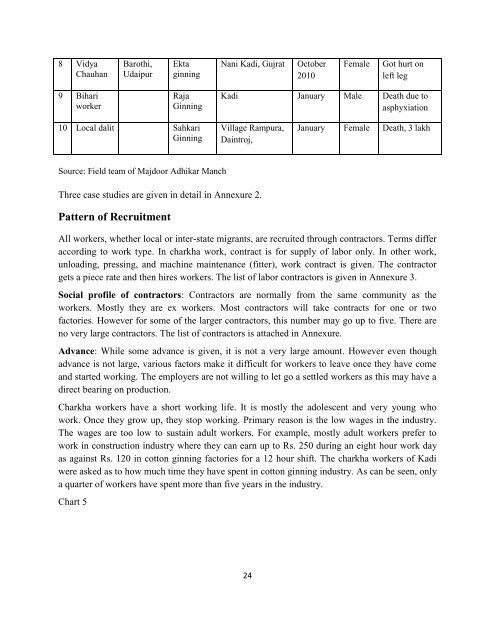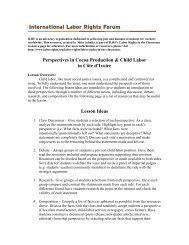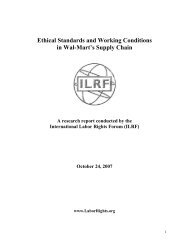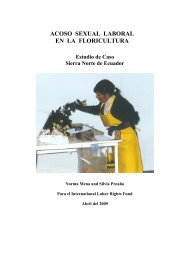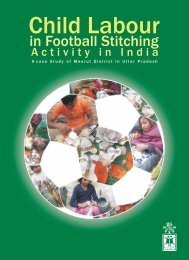Child Labor in Cotton Ginning Report.pdf - International Labor ...
Child Labor in Cotton Ginning Report.pdf - International Labor ...
Child Labor in Cotton Ginning Report.pdf - International Labor ...
You also want an ePaper? Increase the reach of your titles
YUMPU automatically turns print PDFs into web optimized ePapers that Google loves.
8 Vidya<br />
Chauhan<br />
Barothi,<br />
Udaipur<br />
Ekta<br />
g<strong>in</strong>n<strong>in</strong>g<br />
Nani Kadi, Gujrat<br />
October<br />
2010<br />
Female<br />
Got hurt on<br />
left leg<br />
9 Bihari<br />
worker<br />
Raja<br />
G<strong>in</strong>n<strong>in</strong>g<br />
Kadi January Male Death due to<br />
asphyxiation<br />
10 Local dalit Sahkari<br />
G<strong>in</strong>n<strong>in</strong>g<br />
Village Rampura,<br />
Da<strong>in</strong>troj,<br />
January Female Death, 3 lakh<br />
Source: Field team of Majdoor Adhikar Manch<br />
Three case studies are given <strong>in</strong> detail <strong>in</strong> Annexure 2.<br />
Pattern of Recruitment<br />
All workers, whether local or <strong>in</strong>ter-state migrants, are recruited through contractors. Terms differ<br />
accord<strong>in</strong>g to work type. In charkha work, contract is for supply of labor only. In other work,<br />
unload<strong>in</strong>g, press<strong>in</strong>g, and mach<strong>in</strong>e ma<strong>in</strong>tenance (fitter), work contract is given. The contractor<br />
gets a piece rate and then hires workers. The list of labor contractors is given <strong>in</strong> Annexure 3.<br />
Social profile of contractors: Contractors are normally from the same community as the<br />
workers. Mostly they are ex workers. Most contractors will take contracts for one or two<br />
factories. However for some of the larger contractors, this number may go up to five. There are<br />
no very large contractors. The list of contractors is attached <strong>in</strong> Annexure.<br />
Advance: While some advance is given, it is not a very large amount. However even though<br />
advance is not large, various factors make it difficult for workers to leave once they have come<br />
and started work<strong>in</strong>g. The employers are not will<strong>in</strong>g to let go a settled workers as this may have a<br />
direct bear<strong>in</strong>g on production.<br />
Charkha workers have a short work<strong>in</strong>g life. It is mostly the adolescent and very young who<br />
work. Once they grow up, they stop work<strong>in</strong>g. Primary reason is the low wages <strong>in</strong> the <strong>in</strong>dustry.<br />
The wages are too low to susta<strong>in</strong> adult workers. For example, mostly adult workers prefer to<br />
work <strong>in</strong> construction <strong>in</strong>dustry where they can earn up to Rs. 250 dur<strong>in</strong>g an eight hour work day<br />
as aga<strong>in</strong>st Rs. 120 <strong>in</strong> cotton g<strong>in</strong>n<strong>in</strong>g factories for a 12 hour shift. The charkha workers of Kadi<br />
were asked as to how much time they have spent <strong>in</strong> cotton g<strong>in</strong>n<strong>in</strong>g <strong>in</strong>dustry. As can be seen, only<br />
a quarter of workers have spent more than five years <strong>in</strong> the <strong>in</strong>dustry.<br />
Chart 5<br />
24


